ASM Metals HandBook Vol. 8 - Mechanical Testing and Evaluation
Подождите немного. Документ загружается.

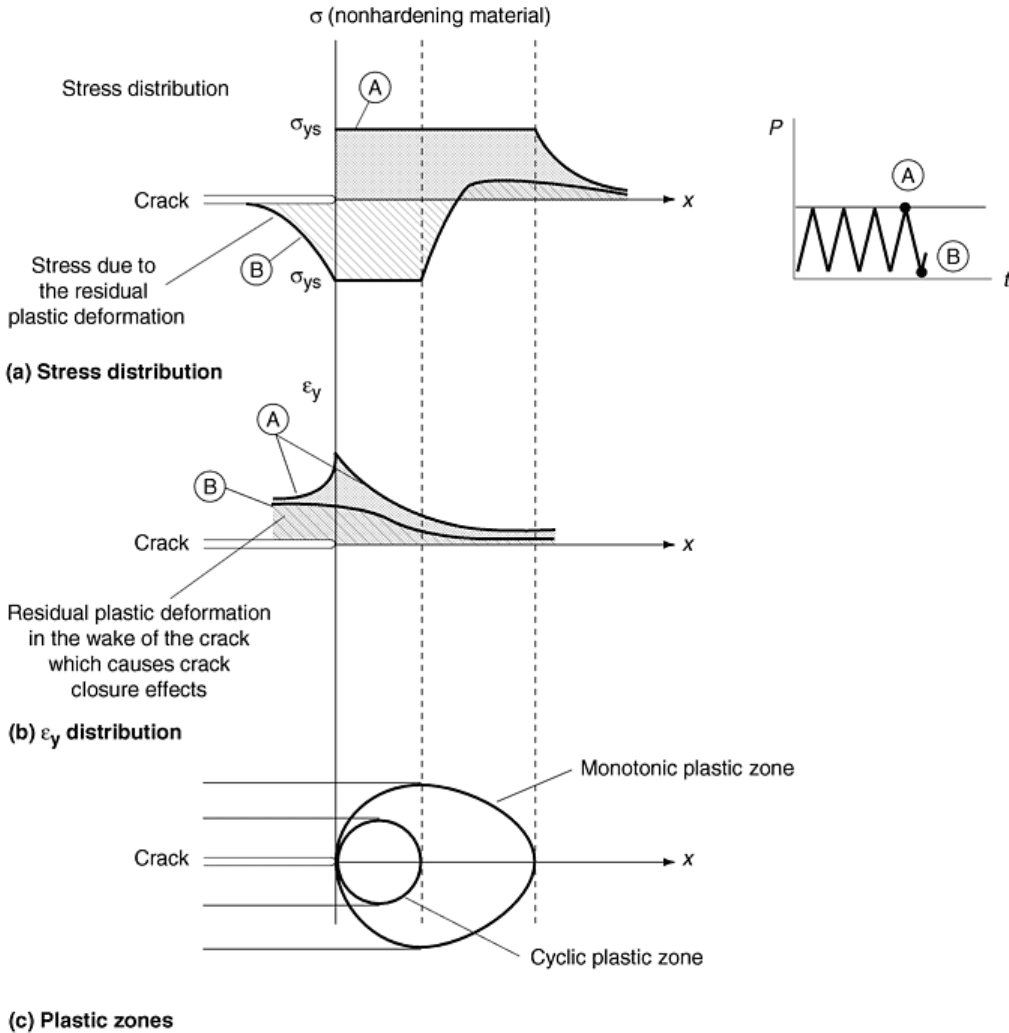
Fig. 4 Schematic of crack-tip conditions during crack closure
Figure 5(a) shows a schematic load-deflection diagram and the crack closure point. Figure 5(b) plots only the
deviation between the total deflection and the linearly predicted deflection, thus highlighting the crack closure
point.

Fig. 5 Load versus displacement diagrams. (a) Diagram showing a change in stiffness at the crack
closure point. (b) A plot of total deflection minus the elasticity calculated deflection amplified to highlight
crack closure. v
e
, elastic displacement
The importance of crack closure varies with the crack growth regime, crack tip material-microstructure
interactions, and the extent of plasticity. Crack closure is more significant in the near-threshold regime (region
I, Fig. 2) than in region II (Fig. 2). Materials in which the crack path is such that rougher crack surfaces are
produced usually exhibit enhanced crack closure levels. The crack closure levels can also increase with
plasticity. For example, during fatigue crack growth in the elastic-plastic regime, crack closure levels take on
added significance (Ref 8, 9).
References cited in this section
1. P.C. Paris and F. Erdogan, J. Basic Eng. (Trans. ASME), Series D, Vol 85, 1963, p 528–534
2. P.C. Paris, Proc. 10th Sagamore Conf., Syracuse University Press, 1965, p 107–132
3. J.R. Griffiths and C.E. Richards, Mater. Sci. Eng., Vol 11, 1973, p 305–315
4. J.C. Grosskruetz, Strengthening in Fracture and Fatigue, Metall. Trans., Vol 3, 1972, p 1255–1262
5. J.R. Rice, in Fatigue Crack Propagation, STP 415, ASTM, 1967, p 247–311
6. N.E. Dowling, in Flaw Growth and Fracture, STP 631, ASTM, 1977, p 139–158
7. Standard Test Method for Measurement of Fatigue Crack Growth Rates, E 647-91, Annual Book of
ASTM Standards, Vol 03.01, 1992, ASTM, p 674–701
8. N.E. Dowling and J.A. Begley, in Mechanics of Crack Growth, STP 590, ASTM, 1976, p 82–103
9. N.E. Dowling, in Cracks and Fracture, STP 601, ASTM, 1977, p 131–158
10. H.S. Lamba, The J-Integral Applied to Cyclic Loading, Eng. Fract. Mech., Vol 7, 1975, p 693–696
11. J.R. Rice, J. Appl. Mech. (Trans. ASME), Vol 35, 1968, p 379–386
12. J.W. Hutchinson, J. Mech. Phys. Solids, Vol 16, 1968, p 337–347

13. J.R. Rice and G.F. Rosengren, J. Mech. Phys. Solids, Vol 16, 1968, p 1–12
14. W.R. Brose and N.E. Dowling, in Elastic-Plastic Fracture, STP 668, ASTM, 1979, p 720–735
15. W. Elber, Fatigue Crack Closure under Cyclic Tension, Eng. Fract. Mech., Vol 2, 1970, p 37–45
16. W. Elber, The Significance of Fatigue Crack Closure, STP 486, ASTM, 1971, p 230–242
Fatigue Crack Growth Testing
Ashok Saxena, Georgia Institute of Technology; Christopher L. Muhlstein, University of California, Berkeley
Test Methods and Procedures
ASTM standard E 647 (Ref 7) is the accepted guideline for fatigue crack growth testing and is applicable to a
wide variety of materials and growth rates.
FCGR testing consists of several steps, beginning with selecting the specimen size, geometry, and crack-length
measurement technique. When planning the tests, the investigator must have an understanding of the
application of FCGR data. Testing is often performed in laboratory air at room temperature; however, any
gaseous or liquid environment and temperature of interest may be used to determine the effect of temperature,
corrosion, or other chemical reaction on cyclic loading (see the appendix “High-Temperature Fatigue Crack
Growth Testing” at the end of this article). Cyclic loading also may involve various waveforms for constant-
amplitude loading, spectrum loading, or random loading.
In addition, many of the conventions used in plane-strain fracture toughness testing (ASTM E 399, Ref 17) are
also used in FCGR testing. For tension-tension fatigue loading, K
Ic
loading fixtures frequently can be used. For
this type of loading, both the maximum and minimum loads are tensile, and the load ratio, R = P
min
/P
max
, is in
the range 0 < R < 1. A ratio of R = 0.1 is commonly used for developing data for comparative purposes.
Cyclic crack growth rate testing in the threshold regime (region I, Fig. 2) complicates acquisition of valid and
consistent data, because the crack growth behavior becomes more sensitive to the material, environment, and
testing procedures. Within this regime, the fatigue mechanisms of the material that slow the crack growth rates
are more significant.
It is extremely expensive to obtain a true definition of ΔK
th
, and in some materials a true threshold may be
nonexistent. Generally, designers are more interested in the FCGR in the near-threshold regime, such as the ΔK
that corresponds to a FCGR of 10
-8
to 10
-10
m/cycle (3.9 × 10
-7
to 10
-9
in./cycle). Because the duration of the
tests increases greatly for each additional decade of near-threshold data (e.g., 10
-8
to 10
-9
to 10
-10
m/cycle), the
precise design requirements should be determined in advance of the test. Although the methods of conducting
fatigue crack threshold testing may differ, ASTM E 647 addresses these requirements.
In all areas of crack growth rate testing, the resolution capability of the crack measuring technique should be
known; however, this knowledge becomes considerably more important in the threshold regime. The smallest
amount of crack-length resolution is desired, because the rate of decreasing applied loads (load shedding) is
dependent on how easily the crack length can be measured. The minimum amount of change in measured crack
growth should be ten times the crack-length measurement precision. It is also recommended that for
noncontinuous load shedding testing, where, [(P
max1
- P
max2
)/P
max1
] > 0.02, the reduction in the maximum load
should not exceed 10% of the previous maximum load, and the minimum crack extension between load sheds
should be at least 0.50 mm (0.02 in.)
In selecting a specimen, the resolution capability of the crack measuring device and the K-gradient (the rate at
which K is increased or decreased) in the specimen should be known to ensure that the test can be conducted
appropriately. If the measuring device is not sufficient, the threshold crack growth rate may not be achieved
before the specimen is separated in two. To avoid such problems, a plot of the control of the stress intensity (K
versus a) should be generated before selection of the specimen.
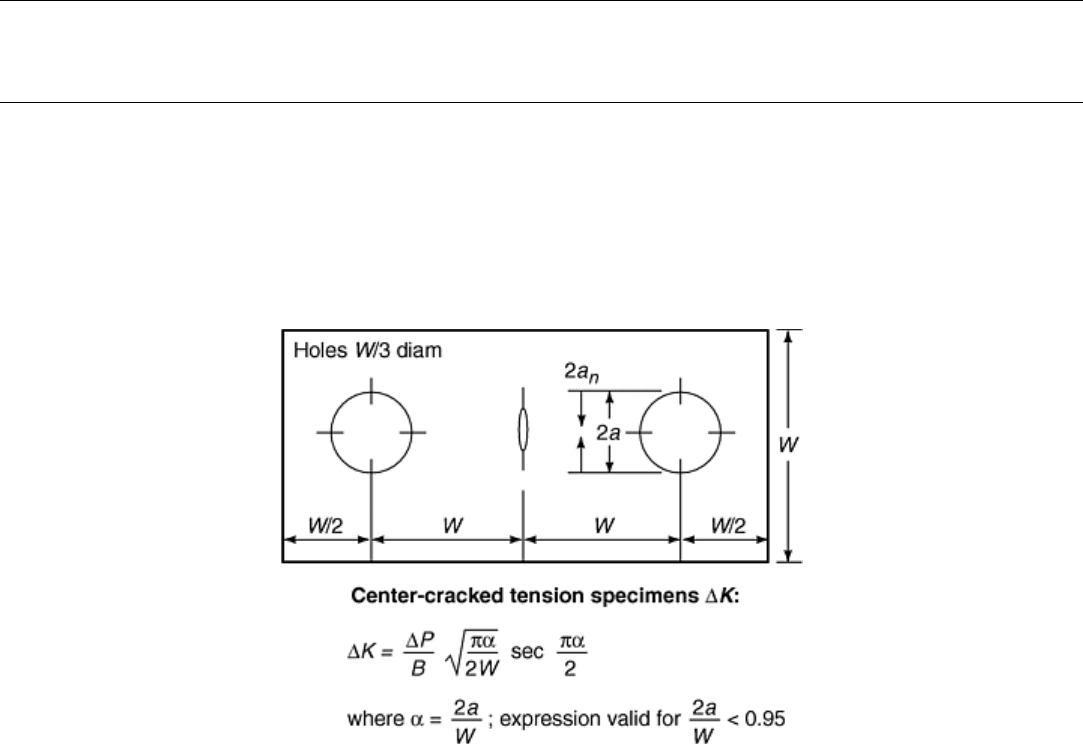
When a new crack-length measuring device is introduced, a new type of material is used, or any other factor is
different from that used in previous testing, the K-decreasing portion of the test should be followed with a
constant load amplitude (K-increasing) to provide a comparison between the two methods. Once a consistency
is demonstrated, constant-load amplitude testing in the low crack growth rate regime is not necessary under
similar conditions.
References cited in this section
7. Standard Test Method for Measurement of Fatigue Crack Growth Rates, E 647-91, Annual Book of
ASTM Standards, Vol 03.01, 1992, ASTM, p 674–701
17. Standard Method for Plane-Strain Fracture Toughness of Metallic Materials, E 399-90, Annual Book of
ASTM Standards, Vol 3.01, 1992, ASTM, p 569–596
Fatigue Crack Growth Testing
Ashok Saxena, Georgia Institute of Technology; Christopher L. Muhlstein, University of California, Berkeley
Specimen Selection and Preparation
The two most widely used types of specimens are the middle-crack tension, MT, and the compact-type
specimen, CT (Fig. 6, 7). However, any specimen configuration with a known stress-intensity factor solution
can be used in FCGR testing, assuming that the appropriate equipment is available for controlling the test and
measuring the crack dimensions.
Fig. 6 Standard center-cracked tension (middle-tension) specimen and ΔK solution. Specimen width (W)
≤ 75 mm (3 in.). 2a
n
machined notch; a, crack length; B, specimen thickness
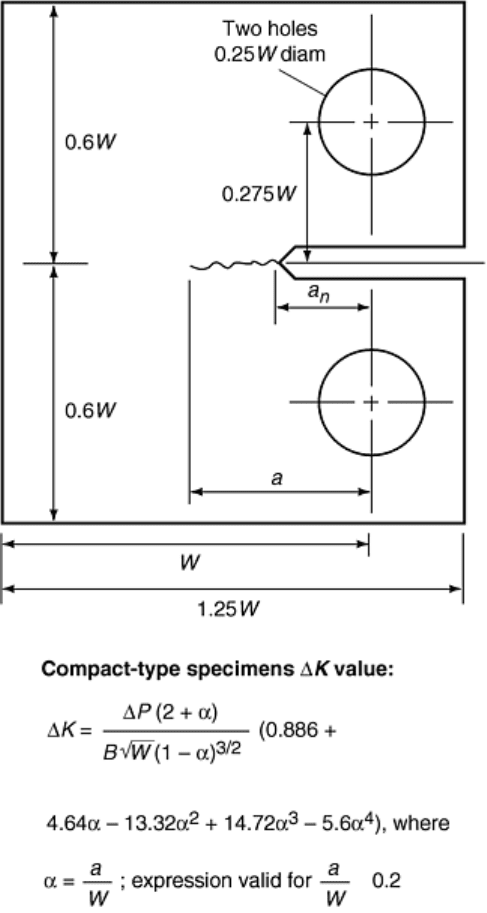
Fig. 7 Standard compact-type specimen and ΔK value (per ASTM E 674). Allowable thickness: W/20 ≤ B
≤ W/4. Minimum dimensions: W = 25 mm (1.0 in.); machined notch size (a
n
) = 0.20W
Specimens used in FCGR testing may be grouped into three categories: pin-loaded (Fig. 6, 7), bend-loaded
(Fig. 8a) and wedge-gripped specimens (Fig. 8b – d). Precisely machined specimens are essential, and ASTM E
647 specifies the recommended tolerances and K-calibrations for CT and MT geometries. Single-edge bend,
arc-shaped, and disk-shaped compact specimen geometries and the corresponding K-calibrations are discussed
in ASTM E 399. Comparable tolerances should be specified for “nonstandard” specimens. The selection of an
appropriate geometry requires consideration of material availability and raw form, desired loading condition,
and equipment limitations.
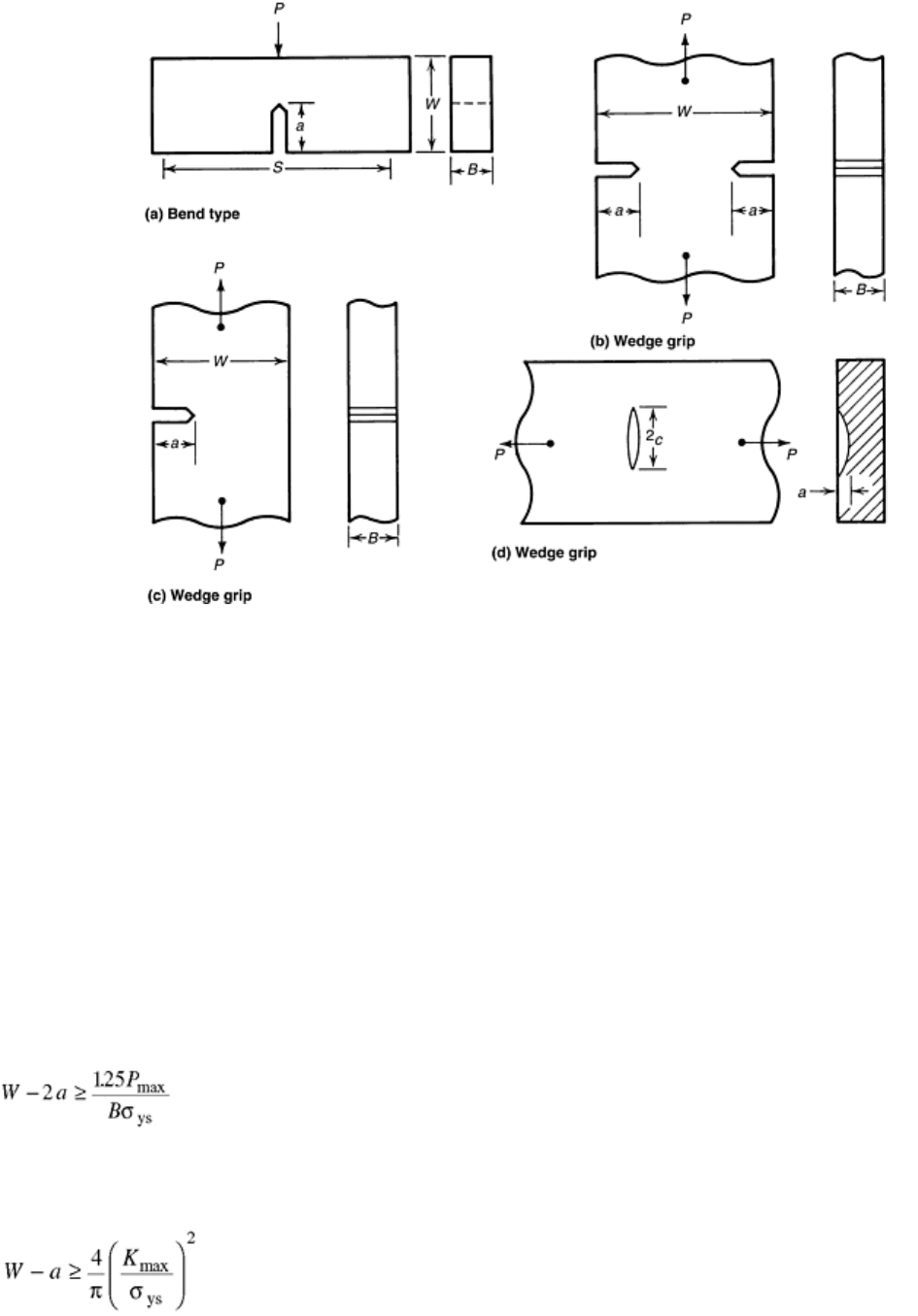
Fig. 8 Alternative crack growth specimen geometries. (a) Single-edge-crack bending specimen. (b)
Double-edge-crack tension specimen. (c) Single-edge-crack tension specimen. (d) Surface-crack tension
specimen
Crack Length and Specimen Size. The applicable range of the stress-intensity solution of a specimen
configuration is very important. Many stress-intensity expressions are valid only over a range of the ratio of
crack length to specimen width (a/W). For example, the expression given in Fig. 7 for the CT specimen is valid
for a/W > 0.2; the expression for the middle-tension (MT) specimen (Fig. 6) is valid for 2a/W < 0.95. The use
of stress-intensity expressions outside the applicable crack-length region can produce significant errors in data.
The size of the specimen must also be appropriate. To follow the rules of LEFM, the specimen must be
predominantly elastic. However, unlike the requirements for plane-strain fracture toughness testing, there are no
specific requirements of minimum specimen thickness. The thickness is considered to be a controlled test
variable and depends on the application. The material characteristics, specimen size, crack length, and applied
load will dictate whether the specimen is predominantly elastic. Because the loading modes of different
specimens vary significantly, each specimen geometry must be considered separately.
For the MT specimen, the following is required:
(Eq 8)
where W - 2a is the uncracked ligament of the specimen (see Fig. 6) and σ
ys
is the 0.2% offset yield strength at
the temperature corresponding to the FCGR data.
For the CT specimen, the following is required:
(Eq 9)
where W - a is the uncracked ligament (Fig. 7). For the CT specimen, the size requirement in Eq 9 limits the
monotonic plastic zone in a plane-stress state to approximately 25% of the uncracked ligament. For both Eq 8
and 9, ASTM E 647 recommends the use of the monotonic yield strength. The size requirements in Eq 8 and 9
are appropriate for low-strain hardening materials (σ
uts
/σ
ys
≤ 1.3), where σ
uts
is the ultimate tensile strength of

the material. For higher-strain-hardening materials, Eq 8 and 9 may be too restrictive. In such situations, the
criteria may be relaxed by replacing the yield strength, σ
ys
, with the effective yield strength, σ
F
:
(Eq 10)
Specimen Thickness. While fatigue crack growth rates have been shown to be relatively insensitive to stress
state (i.e., plane-stress versus plane-strain, Ref 3), there are some practical limitations on specimen thickness.
ASTM E 647 recommends that generally CT specimen thickness (B) range between 5 and 25% of width (W/20
≤ B ≤ W/4). Middle-tension specimens may have thicknesses up to 12% of width (≤W/8). When other specimen
geometries are used, similar ranges for thickness should be employed.
Although a wide variety of specimen thicknesses are permitted, the amount of crack curvature in the specimen
will increase as the thickness increases. Because stress-intensity solutions are based on a straight through-crack,
a significant amount of curvature, if not properly considered, can lead to an error in the data. Crack-curvature
correction calculations are detailed in ASTM E 647. The minimum allowable thickness depends on the gripping
method used; however, the bending strains should not exceed 5% of the nominal strain in the specimen.
Material Form and Microstructure Considerations. The material and its microstructure play an important role in
the selection of an appropriate specimen geometry. Materials with anisotropic microstructures due to
processing, such as rolling or forging, may show large variations in FCGR in different directions (Ref 18). If
the experimental crack growth rate data are to be used for life estimates, the orientation of the specimen should
be selected to represent loading orientations expected in service.
In order to eliminate grain size effects, it is usually recommended that the specimen thickness (B) be greater
than 30 grain diameters (Ref 19, 20). In some instances, such as in large-grain (~3 mm) lamellar γ-α
2
Ti-Al
intermetallic or α-β titanium alloys, the required specimen sizes would be prohibitively expensive, test loads
would be very high, and the component dimensions would probably be less than 30 times the grain size. In such
instances, testing should be performed on thicknesses representative of the component. Curvature of the crack
front and side-to-side variation in crack length due to excessive thickness can also be a problem in thick
specimens, as discussed below.
Loading Considerations. The desired loading conditions play an important role in the specimen geometry and
size selection process. Loading considerations include load ratio, R, residual stresses,K-gradients, and
maintaining small-scale yielding. All specimen geometries are well suited for tension-tension (R > 0) testing.
However, tests that call for negative R (i.e., those with minimum loads less than 0) are restricted to symmetric,
wedge-grip loaded specimens, such as the MT specimens. This limitation is due to questions about the crack-tip
stress field under compressive loads (Ref 7) and difficulties moving through zero load with pin-loaded
specimens.
Residual stresses in the material also have a marked effect on FCGR. Depending on the orientation of the
residual stresses, specimen dimensions or geometries should be altered. Residual stresses through the thickness
of the specimen (i.e., perpendicular to the direction of crack growth) may accelerate or retard crack growth.
When these stresses are not uniform, ASTM E 647 recommends a reduction of the thickness-to-width ratio
(B/W).
The rate at which K increases as the crack extends at a constant-load amplitude is given by the geometry
function f(a/W) and may be a consideration when selecting the most appropriate specimen geometry. Figure 9
shows the effect of geometry on the K-gradient through a variety of specimen geometries. Specimens with
shallower K-gradients are preferable for brittle materials, while the opposite is true for ductile materials.

Fig. 9 K-gradients for a number of fatigue crack growth specimens. Source: Ref 7, 17
Equipment Considerations. Specimen size and geometry also can be influenced by laboratory equipment, such
as the loadframe, loadcell, existing loading fixtures, testing environment, and even the crack-length
measurement apparatus. To minimize cost, specimen sizes and geometries should be selected to use existing
clevises, pins, and other hardware.
Most modern mechanical testing laboratories exclusively use electroservohydraulic loadframes for FCGR
investigations. Current controls and data acquisition technology have hydraulic loadframes more versatile than
the electromechanical systems used previously. When selecting a specimen geometry and size, it is important to
be aware of the load capacity of the actuator and loadframe. Loads that are too high cannot be applied, and
those loads that are too low cannot be controlled with the required accuracy (±2%). In addition, the load cell to
be used during testing must be able to measure the maximum applied load and resolve the lowest expected
amplitudes, as specified in ASTM E 4.
When testing in environments, specimens fit inside ovens, furnaces, or other chambers with ample space left for
clevises, cantilever beam clip gages, and other hardware. Special notch geometries or knife-edge attachment
locations are often necessary for attaching clip gages or other types of extensometers for nonvisual crack-length
measurements using compliance techniques.
Notch and Specimen Preparation. The method by which a notch is machined depends on the specimen material
and the desired notch root radius (ρ). Sawcutting is the easiest method but is generally acceptable only for
aluminum alloys. For a notch root radius of ρ ≤ 0.25 mm (0.010 in.) in aluminum alloys, milling or broaching is
required. A similar notch root radius in low- and medium-strength steels can be produced by grinding. For
high-strength steel alloys, nickel-base superalloys, and titanium alloys, electrical discharge machining may be
necessary to produce a notch root radius of ρ ≤ 0.25 mm (0.010 in.).
The specimen is polished to allow measurement of the crack during the precracking and testing phases of the
experiment. Many specimens can be polished using standard metallography practices. In some instances,
etching of the polished surface may provide better contrast for viewing of the crack. If the specimen is too large
or small to be handled, then hand grinders, finishing sanders, or handheld drills can be used with pieces of
polishing cloth to locally apply the abrasive and create a satisfactory viewing surface. These techniques are
quick and easy to apply, and they are often used when visual measurements are made only during precracking
and subsequent measurements are made by automated techniques, such as electric potential or compliance.
Precracking. The K-calibration functions found in ASTM E 647 and E 399 are valid for sharp cracks within the
range of crack length specified. Consequently, before testing begins, a sharp fatigue crack that is long enough to
avoid the effects of the machined notch must be present in the specimen (0.1B, or 0.1H, or 1 mm [0.040 in.],
whichever is greatest). The process that generates this crack is termed precracking. In general, loads for
precracking should be selected such that the K
max
at the end of precracking does not exceed levels expected at
the start of a test.
For most metals, precracking is a relatively simple process that can be performed under load or displacement
control conditions. Moderate growth rates (1 × 10
-5
m/cycle) can be selected by estimating the necessary ΔK
from growth curves in the literature. Precracking of a specimen prior to testing is conducted at stress intensities
sufficient to cause a crack to initiate from the starter notch and propagate to a length that will eliminate the
effect of the notch. To decrease the amount of time needed for precracking to occur, common practice is to
initiate the precracking at a load above that used during testing and to subsequently reduce the load.
Load generally is reduced uniformly to avoid transient (load-sequence) effects. Crack growth can be arrested
above the threshold stress-intensity value due to formation of the increased plastic zone ahead of the tip of the
advancing crack. Therefore, the step size of the load during precracking should be minimized. Under these
circumstances, the loads should be shed no faster than 20% (per increment of crack extension, as discussed
below) from the previous load increment (Ref 7), which eliminates load-sequence effects on growth rates. As
the crack approaches the final desired size, the percentage can be decreased.
The amount of crack extension between each load decrease must also be controlled. If the step is too small, the
influence of the plastic zone ahead of the crack may still be present. To avoid transient (load-sequence) effects
in the test data, the load range in each step should be applied over a crack-length increment of at least (3π)
(K′
max
/σ
ys
)
2
, where K′
max
is the terminal value of K
max
from the previous load step. This requirement ensures that
the crack extension between load sheds is at least three plastic zone diameters.
The influence of the machined starter notch must be eliminated so that the crack tip conditions are stable. For
CT and MT specimens, this condition requires that the final precrack be at least 10% of the thickness of the
specimen or equivalent to the height of the starter notch, whichever is greater (Ref 7).
Two additional considerations regarding crack shape are the amount of crack variation from the front and back
sides of the specimen and the amount of out-of-plane cracking. Due to microstructural changes through the
specimen thickness, residual stresses (particularly in weldments), or misalignment of the specimen in the grips,
the crack may grow unevenly on the two surfaces. If any two crack-length measurements vary by more than
0.025W or by more than 0.25B (whichever is less), the precracking operation is not suitable, and test results will
not be valid. If a fatigue precrack departs more than ±5° from the plane of symmetry, the specimen is not
suitable for subsequent testing.
Precracking of Brittle Materials. Brittle materials, such as intermetallics and ceramics, can be very difficult to
precrack. It is not uncommon to initiate a flaw that immediately propagates to failure. This transformation is
due, in part, to the increasing K-gradient found in FCGR specimens and the relatively narrow range of ΔK for
stable crack growth.
To improve the chances of successful precracking of brittle materials, chevron notches are advised. Chevron-
notched specimens (Fig. 10) are used for determining the fracture toughness of brittle materials that are difficult
to fatigue precrack. Chevron notches generate decreasing K-gradients at the start of precracking and may be
machined as part of the specimen, or they may be added just prior to testing using a thin diamond wafering
blade. The maximum slope of the chevron notch should be 45°. Precracking of brittle materials should be
performed under displacement control conditions, so that as the crack extends, the load and the applied K
decrease. Lastly, the loads should be increased slowly from low levels due to the stochastic nature of crack
initiation in these materials. If initiation is especially difficult, compressive overloads may assist the process. It
is also helpful to monitor the initiation process with a method other than optical observation. Electric potential
techniques (bulk and foil) and back face strain (BFS) compliance techniques are very effective.
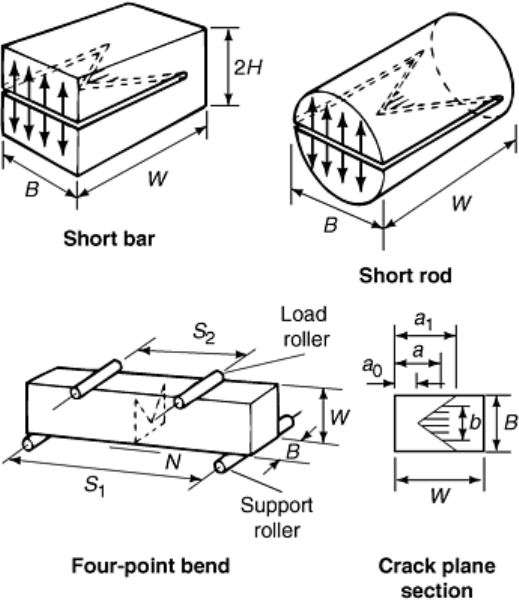
Fig. 10 Schematic of chevron notches in fracture mechanics specimens. Area b is the crack area.
Once precracking has been completed, an accurate optical measurement of the initial crack length, a
0
, must be
made on both sides of the specimen to within 0.10 mm (0.004 in.) or 0.002W (whichever is greatest), or to
within 0.25 mm (0.01 in.) for specimens where W > 127 mm (5 in.). If the crack lengths on the two surfaces
differ by more than 0.25B, then the test will not be valid, because K-calibration functions presume the existence
of a straight crack front. Middle-tension specimens further require that both halves of the precrack be the same
length to within 0.025W. In addition, ASTM E 647 requires that cracks lie on the centerline such that the crack
is no more than ±20° from a centerline over a distance 0.1W. Once the precrack has been measured and side-to-
side variation and distance from centerline have been established, testing may begin.
Gripping of the specimen must be done in a manner that does not violate the stress-intensity solution
requirements. For example, in a single-edge notched specimen, it is possible to produce a grip that permits
rotation in the loading of the specimen, or it is possible to produce a rigid grip. Each of these grips requires a
different stress-intensity solution. In grips that are permitted to rotate, such as the CT specimen grip, the pin and
hole clearances must be designed to minimize friction. It is also advisable to consider lateral movement above
and below the grips.
When appropriate, the use of a lubricant is recommended to reduce friction. In thick samples, the amount of
bending in the pins should be minimized. Finally, the alignment of the system should be checked carefully to
avoid undesirable bending stresses, which generally cause uneven cracking. Alignment can be easily checked
using a strain gage specimen of a geometry similar to that used in the test program. Generally, bending strains
should not exceed 5% of the nominal strain to be used in the test program.
Gripping arrangements for CT and CCT specimens are described in ASTM E 647 (Ref 7). For a CCT specimen
less than 75 mm (3 in.) in width, a single pin grip is generally suitable. Wider specimens generally require
additional pins, friction gripping, or some other method to provide sufficient strength in the specimen and grip
to prohibit failure at undesirable locations, such as in the grips.
References cited in this section
3. J.R. Griffiths and C.E. Richards, Mater. Sci. Eng., Vol 11, 1973, p 305–315
